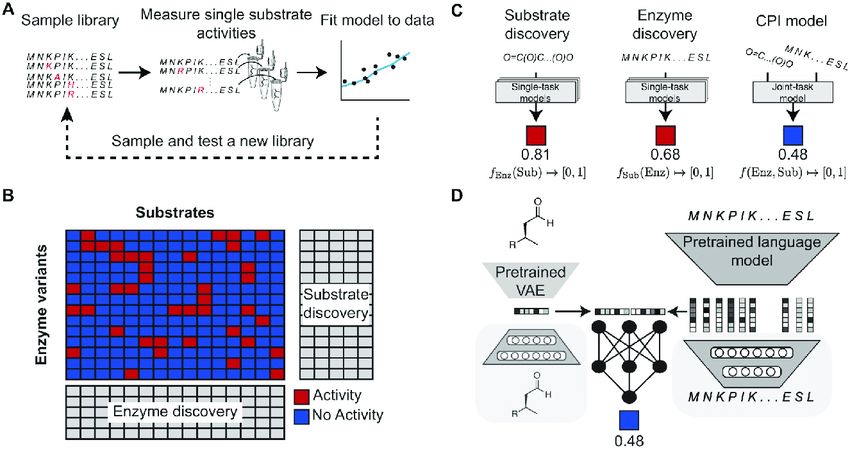Designing enzymes for novel substrate classes is a groundbreaking scientific method that entails the development of enzymes to interact with new substrate categories. This transformative tool could significantly enhance the capabilities of biological systems, facilitating the creation of new bioactive molecule classes. Research in this field is critical for advancing our knowledge of enzyme-substrate interactions and driving the development of innovative biotechnologies.
 Enzyme-substrate interaction modeling strategies (Samuel Goldman, 2022)
Enzyme-substrate interaction modeling strategies (Samuel Goldman, 2022)
Service Process
When designing enzymes for novel substrate classes, we follow a systematic process to optimize results. This process includes four fundamental steps, each crucial to achieving our project goals. Here's a detailed overview of what to expect during our collaboration:
- Discussion and Understanding of Project Goals: Firstly, we thoroughly discuss your project goals and requirements. This step helps us understand your needs, expectations, and how our services can meet them. It's vital for establishing the project foundation and aligning our teams.
- Initial Enzyme Design or Modification: Then, we progress to the initial enzyme design or modification stage. Utilizing our extensive experience and innovative techniques, we either create a new enzyme or alter an existing one to fulfill the project requirements. This stage involves manipulating biological components to achieve the desired outcome.
- Testing the Enzyme with Novel Substrate Classes: After the design or modification phase, we examine the enzyme with new substrate classes. This step confirms the effectiveness and efficiency of the design or modification by observing the enzyme's performance with varying substrates.
- Employing an Iterative Process: Finally, we apply an iterative process. This means the design and testing phases are not one-time events. Instead, they are repeated until we achieve the desired results. This approach ensures accuracy and precision, enabling us to make necessary adjustments and enhancements throughout the process.
We're here to assist you. If you have any questions, need more information, or would like to discuss a potential project, please don't hesitate to contact us. Our team is always eager to help and share our expertise.
Applications
| Application |
Description |
| Bioremediation |
Enzymes can be designed to degrade pollutants and contaminants in various environments, aiding in environmental cleanup. For instance, enzymes can be engineered to break down complex hydrocarbons in soil and water. |
| Biofuel Production |
Enzymes are crucial in the conversion of biomass into biofuels such as ethanol and biodiesel. Designing enzymes with enhanced activity and stability towards lignocellulosic substrates can improve the efficiency and economics of biofuel production. |
| Pharmaceutical Industry |
Enzymes play a vital role in drug synthesis and manufacturing. Designing enzymes for novel substrate classes can facilitate the synthesis of complex pharmaceutical compounds more efficiently and sustainably. |
| Agriculture |
Enzymes can be tailored to improve crop yield and quality. For example, enzymes engineered for novel substrate classes can enhance nutrient uptake in plants or assist in the degradation of crop residues for soil enrichment. |
| Food Industry |
Enzymes are used in various food processing applications such as flavor enhancement, texture modification, and preservation. Designing enzymes for novel substrates can enable the development of innovative food products with improved nutritional profiles and sensory attributes. |
| Waste Management |
Enzymes can be employed to break down organic waste materials into valuable products such as compost and biofertilizers. Designing enzymes for novel substrate classes expands the scope of waste management strategies, contributing to resource recovery and sustainability. |
| Industrial Biocatalysis |
Enzymes are widely used as biocatalysts in industrial processes for the production of chemicals, polymers, and specialty compounds. Designing enzymes for novel substrate classes can open up new avenues for the synthesis of high-value products with improved efficiency and specificity. |
| Environmental Monitoring |
Enzymes can be utilized in biosensors for detecting pollutants and monitoring environmental parameters. Designing enzymes for novel substrate classes can enhance the sensitivity and selectivity of biosensors, enabling more accurate and rapid detection of environmental contaminants. |
FAQs
Below is a list of frequently asked questions about our services in designing enzymes for novel substrate classes to help you better understand our services. If you have more specific or detailed questions, don't hesitate to get in touch with us directly.
Q: When we talk about a substrate in this context, what exactly do we mean?
A: In the realm of biochemistry, a substrate is a molecule that becomes the focus of an enzyme's action. It is the groundwork upon which an enzyme performs its vital catalytic activity, enabling a specific chemical reaction to take place.
Q: Could you elaborate on why it's crucial to design enzymes for novel substrate classes?
A: The design of enzymes for novel substrate classes is a critical area of research. It allows us to create new bioactive molecules and expand the capabilities of biological systems. This process is pivotal in providing innovative solutions in various scientific and medical fields, supporting the development of cutting-edge applications.
Q: What does the process of designing enzymes for novel substrate classes entail?
A: The intricate process of designing enzymes for novel substrate classes requires a comprehensive understanding of enzyme-substrate interactions. It involves modifying existing enzymes or designing completely new ones from scratch, and then executing rigorous testing of these enzymes with the new substrate classes to ensure their effectiveness.
Q: What are the wide-ranging applications of this innovative technology?
A: This technology finds extensive application in a variety of fields. Some of the major areas where it proves instrumental include drug discovery, where it aids in the development of new therapeutics, bioenergy production, where it assists in creating sustainable energy solutions, and environmental remediation, where it helps in dealing with various environmental challenges.
Q: How can I avail myself of your expert service?
A: To avail yourself of our services, you can get in touch with us to discuss the specifics of your project. Our team will assist you in understanding how our services can be best tailored to meet your unique needs and objectives.
Q: What is the technical route for designing enzymes for novel substrate classes?
A: The technical route for designing enzymes for novel substrate classes necessitates an in-depth understanding of enzyme-substrate interactions. It involves modifying existing enzymes or the creation of new ones, followed by rigorous testing of these enzymes with the novel substrate classes to assess their functionality and effectiveness.
Q: Can your service be customized to better suit my individual needs?
A: Absolutely, we pride ourselves on our flexibility. We can certainly tailor our services to meet the specific needs of your project. We are committed to providing solutions that are the best possible fit for your unique requirements.
Q: How long does the process of designing enzymes for novel substrate classes take?
A: The timeline can vary depending on the complexity of the project. We strive to complete each project as efficiently as possible while ensuring high-quality results.
Q: How do you ensure the quality and effectiveness of the designed enzymes?
A: We use a rigorous testing process to ensure the effectiveness of the designed enzymes. Additionally, we continuously refine our designs based on the test results to ensure optimal performance.
Q: Can I request modifications to the enzymes after they have been designed?
A: Yes, we offer follow-up support and modifications as needed to ensure the enzymes meet your project requirements.

































 Enzyme-substrate interaction modeling strategies (Samuel Goldman, 2022)
Enzyme-substrate interaction modeling strategies (Samuel Goldman, 2022)